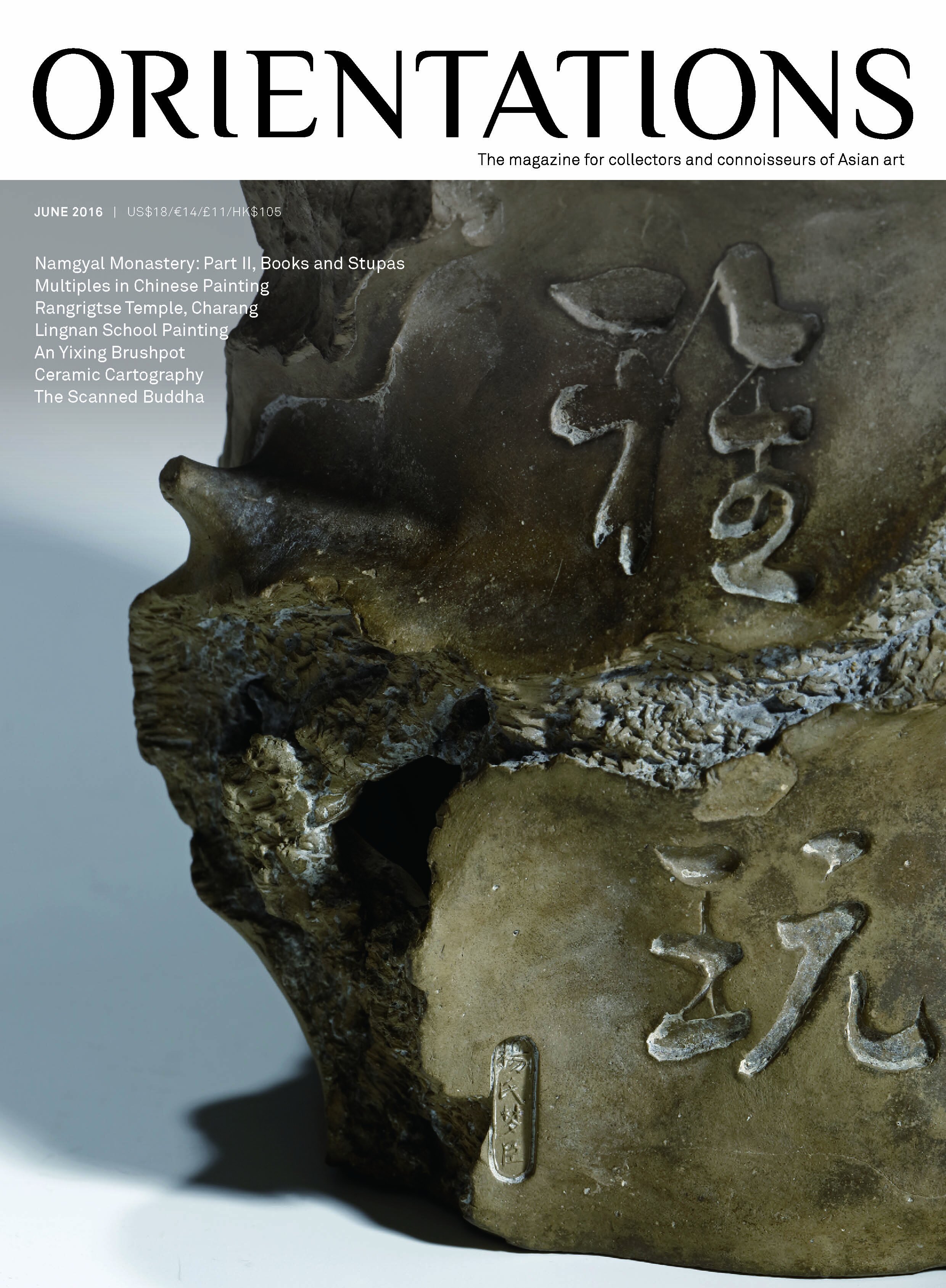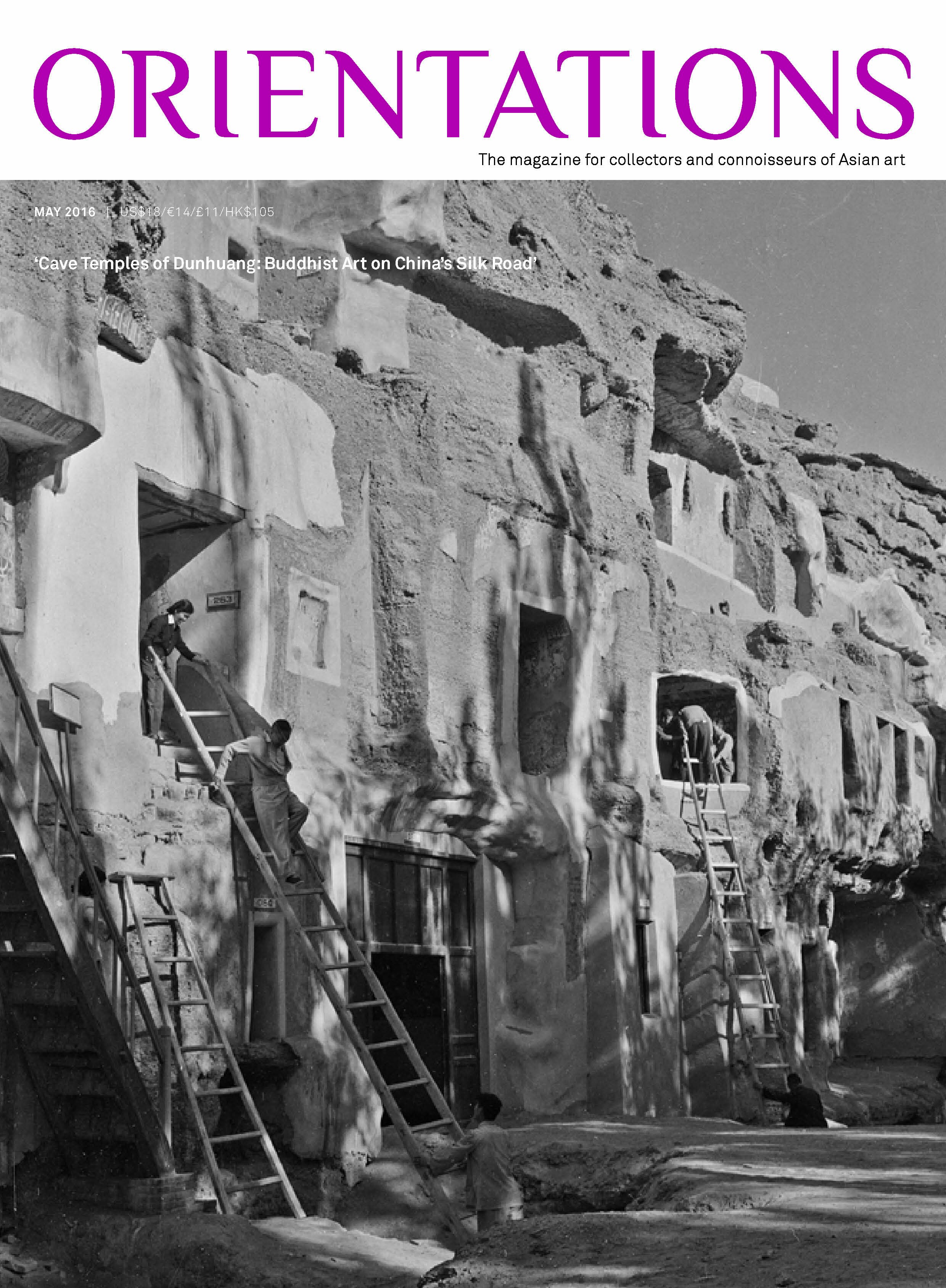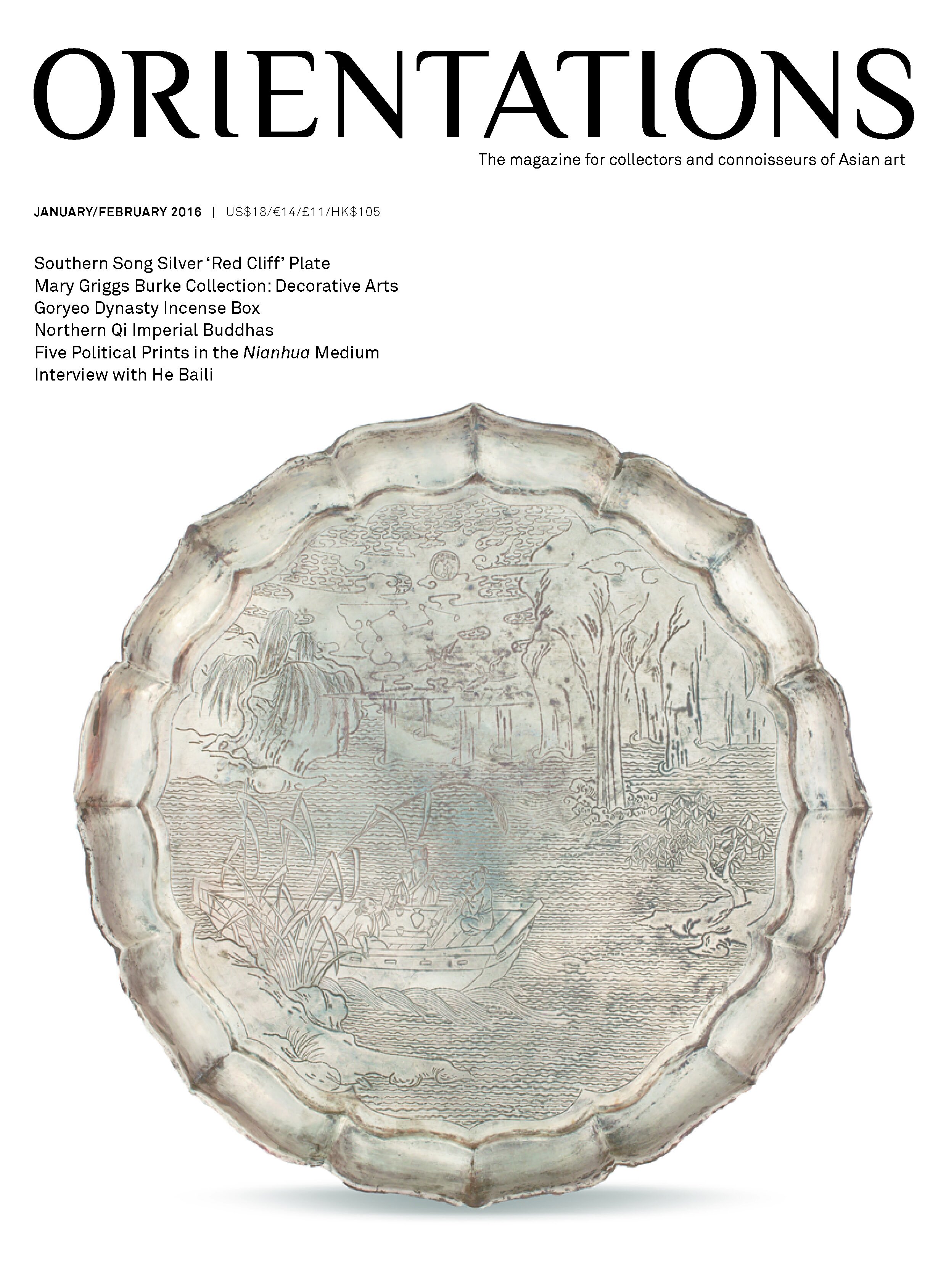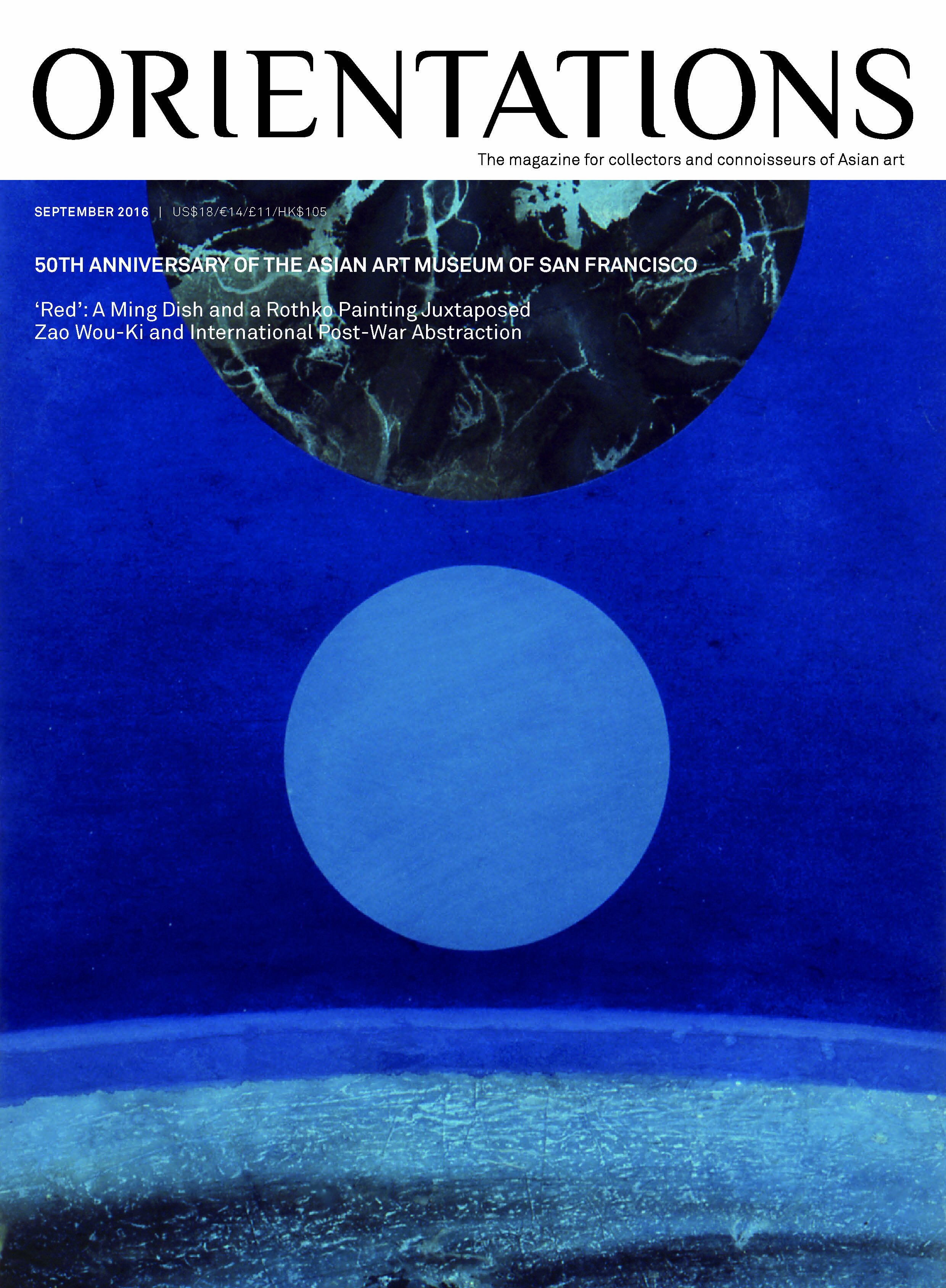JUN 2016
VOLUME 47 - NUMBER 5
The documentation of Himalayan monastic collections opens up new perspectives on regional styles, as well as on collection management, object interpretation and display, as Christian Luczanits emphasizes in the second part of his article on Namgyal monastery, Mustang. Here, he introduces more of the portable heritage of the collection, including a hitherto unknown illustrated proto-Kanjur. Through an analysis of murals and statues at the remote temple of Rangrigtse in Himachal Pradesh, Peter van Ham and Gerald Kozicz find evidence of a close connection to the spiritual centres of Guge, and representations from three different phases of West Tibetan art history. Returning to portable heritage, Michael Henss and Eberhard Lehmann apply advanced scanning techniques to reveal the inner contents of Buddhist images.
In the first of three features on Chinese art, Clarissa von Spee reassesses a group of misattributed works in the British Museum collection that came from Japan in the 19th century, to contribute to our understanding of the scope and complexity of multiple versions in Chinese painting. Szeto Yuen-kit traces the emergence of the Lingnan school in southern China, which sought to innovate traditional Chinese painting. Meanwhile, Ruoming Wu discovers that the inscriptions on a clay brushpot yield much information about international trade in the early 20th century. Finally, collector Betty Lo highlights the opulence of traditional Mongolian jewellery with a look at three distinct styles.
FEATURES
Christian Luczanits. Portable Heritage in the Himalayas The Example of Namgyal Monastery, Mustang: Part II, Books and Stupas
Clarissa von Spee. Multiples in Chinese Painting: A Reassessment of the British Museum’s Anderson Collection
Peter van Ham and Gerald Kozicz. Rangrigtse Temple at Charang, Western Himalayas: West Tibetan Art Periods Combined
Szeto Yuen-kit. Gao Jianfu: A Pioneer of the Lingnan School of Painting
Ruoming Wu. An Yixing Brushpot: An Example of Relations between China and the US in the early 20th Century
Richard A. Pegg. Ceramic Cartography: Japanese Map Plates in the Tenpo Era (1830–44)
Michael Henss and Eberhard Lehmann. The Scanned Buddha: Neutron Radiography and Tomography of Tibetan Buddhist Metal Images
Betty Lo. Crowning Achievements The Splendour of Mongolian Headdresses
PREVIEWS & REVIEWS
Exhibition Review
NEWS
Willard G. Clark (1930–2015)
News
In and Around the Galleries
COMMENTARY
Commentary: Does ‘Islamic Art’ Exist in East Asia? A Critical Commentary on the State of Asian Art Research
VOLUME 47 - NUMBER 5
The documentation of Himalayan monastic collections opens up new perspectives on regional styles, as well as on collection management, object interpretation and display, as Christian Luczanits emphasizes in the second part of his article on Namgyal monastery, Mustang. Here, he introduces more of the portable heritage of the collection, including a hitherto unknown illustrated proto-Kanjur. Through an analysis of murals and statues at the remote temple of Rangrigtse in Himachal Pradesh, Peter van Ham and Gerald Kozicz find evidence of a close connection to the spiritual centres of Guge, and representations from three different phases of West Tibetan art history. Returning to portable heritage, Michael Henss and Eberhard Lehmann apply advanced scanning techniques to reveal the inner contents of Buddhist images.
In the first of three features on Chinese art, Clarissa von Spee reassesses a group of misattributed works in the British Museum collection that came from Japan in the 19th century, to contribute to our understanding of the scope and complexity of multiple versions in Chinese painting. Szeto Yuen-kit traces the emergence of the Lingnan school in southern China, which sought to innovate traditional Chinese painting. Meanwhile, Ruoming Wu discovers that the inscriptions on a clay brushpot yield much information about international trade in the early 20th century. Finally, collector Betty Lo highlights the opulence of traditional Mongolian jewellery with a look at three distinct styles.
FEATURES
Christian Luczanits. Portable Heritage in the Himalayas The Example of Namgyal Monastery, Mustang: Part II, Books and Stupas
Clarissa von Spee. Multiples in Chinese Painting: A Reassessment of the British Museum’s Anderson Collection
Peter van Ham and Gerald Kozicz. Rangrigtse Temple at Charang, Western Himalayas: West Tibetan Art Periods Combined
Szeto Yuen-kit. Gao Jianfu: A Pioneer of the Lingnan School of Painting
Ruoming Wu. An Yixing Brushpot: An Example of Relations between China and the US in the early 20th Century
Richard A. Pegg. Ceramic Cartography: Japanese Map Plates in the Tenpo Era (1830–44)
Michael Henss and Eberhard Lehmann. The Scanned Buddha: Neutron Radiography and Tomography of Tibetan Buddhist Metal Images
Betty Lo. Crowning Achievements The Splendour of Mongolian Headdresses
PREVIEWS & REVIEWS
Exhibition Review
NEWS
Willard G. Clark (1930–2015)
News
In and Around the Galleries
COMMENTARY
Commentary: Does ‘Islamic Art’ Exist in East Asia? A Critical Commentary on the State of Asian Art Research
VOLUME 47 - NUMBER 5
The documentation of Himalayan monastic collections opens up new perspectives on regional styles, as well as on collection management, object interpretation and display, as Christian Luczanits emphasizes in the second part of his article on Namgyal monastery, Mustang. Here, he introduces more of the portable heritage of the collection, including a hitherto unknown illustrated proto-Kanjur. Through an analysis of murals and statues at the remote temple of Rangrigtse in Himachal Pradesh, Peter van Ham and Gerald Kozicz find evidence of a close connection to the spiritual centres of Guge, and representations from three different phases of West Tibetan art history. Returning to portable heritage, Michael Henss and Eberhard Lehmann apply advanced scanning techniques to reveal the inner contents of Buddhist images.
In the first of three features on Chinese art, Clarissa von Spee reassesses a group of misattributed works in the British Museum collection that came from Japan in the 19th century, to contribute to our understanding of the scope and complexity of multiple versions in Chinese painting. Szeto Yuen-kit traces the emergence of the Lingnan school in southern China, which sought to innovate traditional Chinese painting. Meanwhile, Ruoming Wu discovers that the inscriptions on a clay brushpot yield much information about international trade in the early 20th century. Finally, collector Betty Lo highlights the opulence of traditional Mongolian jewellery with a look at three distinct styles.
FEATURES
Christian Luczanits. Portable Heritage in the Himalayas The Example of Namgyal Monastery, Mustang: Part II, Books and Stupas
Clarissa von Spee. Multiples in Chinese Painting: A Reassessment of the British Museum’s Anderson Collection
Peter van Ham and Gerald Kozicz. Rangrigtse Temple at Charang, Western Himalayas: West Tibetan Art Periods Combined
Szeto Yuen-kit. Gao Jianfu: A Pioneer of the Lingnan School of Painting
Ruoming Wu. An Yixing Brushpot: An Example of Relations between China and the US in the early 20th Century
Richard A. Pegg. Ceramic Cartography: Japanese Map Plates in the Tenpo Era (1830–44)
Michael Henss and Eberhard Lehmann. The Scanned Buddha: Neutron Radiography and Tomography of Tibetan Buddhist Metal Images
Betty Lo. Crowning Achievements The Splendour of Mongolian Headdresses
PREVIEWS & REVIEWS
Exhibition Review
NEWS
Willard G. Clark (1930–2015)
News
In and Around the Galleries
COMMENTARY
Commentary: Does ‘Islamic Art’ Exist in East Asia? A Critical Commentary on the State of Asian Art Research






